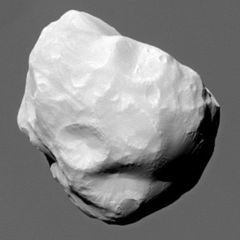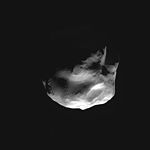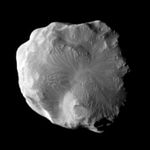- Helene (moon)
-
Helene  Cassini image of Helene against the backdrop of Saturn's clouds (March 3, 2010)Discovery
Cassini image of Helene against the backdrop of Saturn's clouds (March 3, 2010)DiscoveryDiscovered by Laques and
LecacheuxDiscovery site Pic du Midi Observatory Discovery date March 1, 1980 DesignationsAlternate name(s) Helene
Dione B
Saturn XII (12)
S/1980 S 6Semi-major axis 377,396 km Eccentricity 0.0022 Orbital period 2.736915 d[1] Inclination 0.199° (to Saturn's equator) Satellite of Saturn
Dione (L4 Trojan)Physical characteristicsDimensions 43.4×38.2×26 km[2] Mean radius 17.6 ± 0.4 km[2] Albedo 1.67 ± 0.20 (geometric)[3] Helene (
 /ˈhɛlɨniː/ hel-ə-nee;[4] Greek: Ἑλένη) is a moon of Saturn. It was discovered by Pierre Laques and Jean Lecacheux in 1980 from ground-based observations at Pic du Midi Observatory, and was designated S/1980 S 6.[5] In 1988 it was officially named after Helen of Troy, who was the granddaughter of Cronus (Saturn) in Greek mythology.[6] The moon is also designated Saturn XII (12), a number which it received in 1982, under the designation Dione B,[7] because it is co-orbital with Dione and located in its leading Lagrangian point (L4). It is one of four known trojan moons.
/ˈhɛlɨniː/ hel-ə-nee;[4] Greek: Ἑλένη) is a moon of Saturn. It was discovered by Pierre Laques and Jean Lecacheux in 1980 from ground-based observations at Pic du Midi Observatory, and was designated S/1980 S 6.[5] In 1988 it was officially named after Helen of Troy, who was the granddaughter of Cronus (Saturn) in Greek mythology.[6] The moon is also designated Saturn XII (12), a number which it received in 1982, under the designation Dione B,[7] because it is co-orbital with Dione and located in its leading Lagrangian point (L4). It is one of four known trojan moons.Exploration
Helene was initially observed from Earth in 1980,[5] and Voyager flybys of Saturn in the early 1980s allowed much closer views. The Cassini–Huygens mission, which went into orbit around Saturn in 2004, provided still better views, and allowed more in-depth analysis of the moon, including views of the surface under different lighting conditions. Some of the closest images of Helene to date are from the Cassini spacecraft's 1800 km flyby on March 3, 2010, and another very successful imaging sequence occurred in June 2011. There have been many other approaches over the course of the C-H mission, and future flybys may yield even more data.
Selected observations
Mostly raw greyscale images with near infrared or ultraviolet channels.
 The moon's Saturn-facing side, lit by Saturnshine (Cassini, March 2010)
The moon's Saturn-facing side, lit by Saturnshine (Cassini, March 2010)
 Cassini image from March 3, 2010
Cassini image from March 3, 2010
 Voyager 2 image (August 1981)
Voyager 2 image (August 1981)
References
- ^ NASA Celestia
- ^ a b Thomas, P. C. (2010). "Sizes, shapes, and derived properties of the saturnian satellites after the Cassini nominal mission". Icarus 208: 395–401. Bibcode 2010Icar..208..395T. doi:10.1016/j.icarus.2010.01.025. http://www.ciclops.org/media/sp/2011/6794_16344_0.pdf.
- ^ Verbiscer, A.; French, R.; Showalter, M.; Helfenstein, P. (2007). "Enceladus: Cosmic Graffiti Artist Caught in the Act". Science 315 (5813): 815. Bibcode 2007Sci...315..815V. doi:10.1126/science.1134681. PMID 17289992. p. 815 (supporting online material, table S1)
- ^ /ˈhɛlɨniː/ hel-ə-nee is the regular pronunciation, as expected from the Greek etymology, but /hɨˈliːniː/ hə-lee-nee and /hɨˈliːn/ hə-leen are also heard.
- ^ a b IAUC 3496: Satellites of Saturn 1980 July 31 (discovery)
- ^ IAUC 4609: Satellites of Saturn and Uranus 1988 June 8 (naming the moon)
- ^ Transactions of the International Astronomical Union, Vol. XVIIIA, 1982 (mentioned in IAUC 3872: Satellites of Jupiter and Saturn, 1983 September 30)
External links
Listen to this article (info/dl)
This audio file was created from a revision of Helene (moon) dated 2010-02-06, and does not reflect subsequent edits to the article. (Audio help)More spoken articles- Helene Profile by NASA's Solar System Exploration
- The Planetary Society: Helene
- Helene has two faces - The Planetary Society : Helene Mini Atlas - Mar. 11, 2010
- Cassini catches Helene - The Planetary Society : Video & Views - Jun. 20, 2011
Moons of Saturn Generally listed in increasing distance from Saturn. Temporary names in italics.Ring shepherds - S/2009 S 1
- Propeller moonlets
- Pan
- Daphnis
- Atlas
- Prometheus
- ?(S/2004 S 6
- S/2004 S 4
- S/2004 S 3)
- Pandora
Co-orbitals G Ring - Aegaeon
Inner large
(with Trojans)Alkyonides Outer large Inuit group Norse group Gallic group Categories:- Moons of Saturn
- Trojan moons
Wikimedia Foundation. 2010.





